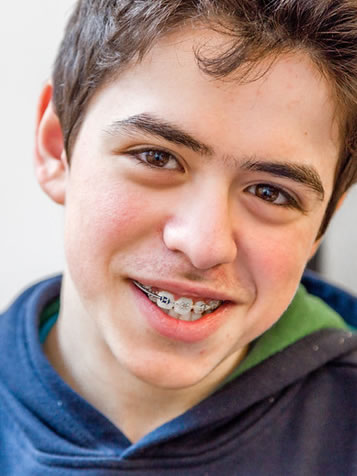The American Association of Orthodontists recommends all children geta check-up with an orthodontic specialist no later than age 7. In an ideal situation, we would prefer for a child to lose all of his/her "baby" teeth and most of the adult teeth growing in before recommending COMPREHENSIVE orthodontic treatment. Unfortunately, each child is unique and some will have dental development problems that need to be addressed early.



Early treatment (Phase I) may prevent or intercept more serious problems from developing and may make treatment at a later age shorter and less complicated.
In some cases, the orthodontist will be able toachieve results that may not be possible once the face and jaws have finished growing. Early treatment may give Dr. To the chance to:
- Guide jaw growth Lower the risk of trauma to protruded front teeth
- Correct harmful oral habits Improve appearance Guide permanent teeth into a more favorable position
- Create a more pleasing arrangement of teeth, lips and face
PHASE ONE
The American Association of Orthodontists recommends all children get a check-up with an orthodontic specialist no later than age 7. In an ideal situation, we would prefer for a child to lose all of his/her "baby" teeth and most of the adult teeth growing in before recommending Comprehensive Treatment. Unfortunately, each child is unique and some will have dental development problems that cannot be delayed until all "baby" teeth are lost. (Please insert the 9 photos from the "problems to watch for in growing children" pdf). Thus, Early Treatment (Phase One) may prevent or intercept more serious problems from developing and may make treatment at a later age shorter and less complicated. In some cases, Dr. To will be able to achieve results that may not be possible once the face and jaws have finished growing. Early treatment may give Dr. To the chance to:
- Guide jaw growth
- Lower the risk of trauma to protruded front teeth
- Correct harmful oral habits
- Improve appearance
- Guide permanent teeth into a more favorable position
- Create a more pleasing arrangement of teeth, lips and face
Phase One usually takes 8-16 months depending on the complexity of the problem.
RESTING PERIOD
Once Phase One treatment has been completed, the remaining "baby" teeth are allowed to exfoliate. A retainer is usually needed to maintain space as permanent teeth are left alone to erupt on their own. A successful first phase will have created room for permanent teeth to find an eruption path. Otherwise, they may become impacted or severely displaced. Periodic recall appointments for observation are necessary, usually on a six-month basis to monitor a child's progress and dental development.
PHASE TWO
Once the majority of the remaining teeth have erupted, the young patient is then re-evaluated for the need of Phase Two treatment. It usually involves full upper and lower braces. The goal of the second phase is:
1. To align all upper and lower permanent teeth
2. To close any unnecessary spaces
3. To establish a proper bite between upper and lower teeth for optimal function
Phase Two can take from 12-24 months depending on how the remaining permanent teeth grew in and complexity of the patient's bite.
Schedule Your Consultation - If your child is showing signs of a crossbite, or other bite issue, schedule an appointment with our team. Contact us today for your COMPLIMENTARY EXAM @972-492-3900.
